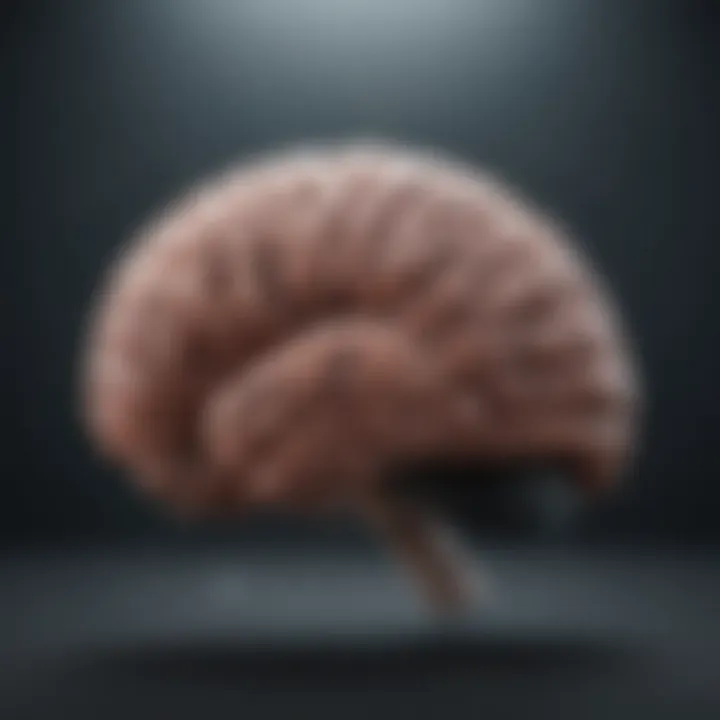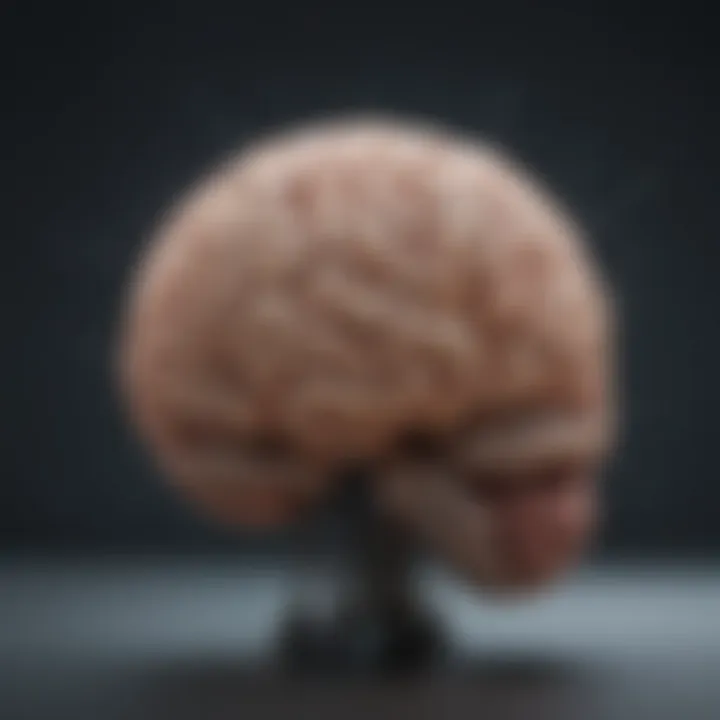Understanding Brain Function: Fast vs. Slow Cognition


Intro
The human brain is an incredibly complex organ, essential for all our thoughts and actions. It operates on two main cognitive styles which can be referred as fast brain and slow brain functions. Understanding these distinctions is vital for appreciating how we process information, make decisions, and engage with the world around us. This article offers an in-depth exploration of these cognitive processes, aiming to clarify how each style influences areas like learning, creativity, and critical thinking.
Research Highlights
Overview of Key Findings
Recent studies reveal that fast brain functions are linked with speed and instinct, allowing for rapid decision-making. This system tends to rely on heuristics and emotional responses. In contrast, slow brain functions facilitate more considered and analytical thinking. This system engages when individuals face complex problems requiring detailed evaluation of options.
The interplay between these two systems is fascinating. Research often suggests that a balance between them can lead to better decision-making and improved learning outcomes. Each system has its strengths and weaknesses, thus showing the need for their understanding in a variety of contexts.
Significance of the Research
Recognizing the differences between fast and slow brain functions provides insight into a range of fields, from education to mental health. For educators, understanding these processes can inform teaching strategies, ensuring that they cater to both instinctual and analytical styles of learning. For professionals, recognizing when to rely on fast or slow thinking can enhance productivity, creativity, and problem-solving capabilities.
"The brain's complexity necessitates a holistic approach to understand its various functions and mechanisms."
Cognitive Functions of Fast Brain
Fast brain functions are characterized by quick cognitive processing. This system operates largely on intuition and emotion. It is primarily engaged in day-to-day situations requiring rapid responses. For example, think about how you drive a car; many decisions are made instantly, guided by instinct rather than in-depth analysis.
When we analyze how the fast brain functions:
- Heuristic Processing: Fast brain often uses mental shortcuts for decision-making.
- Emotional Responses: Often, emotional context drives quick responses.
Cognitive Functions of Slow Brain
In contrast, slow brain functions take time to engage. This system facilitates deeper thinking and reflection. It is pivotal during tasks that require thorough analysis, such as scientific reasoning or strategic planning.
The characteristics of slow brain functions typically include:
- Analytical Thinking: Engages logical reasoning to evaluate information.
- Deliberation: Takes time to weigh options before making a decision.
Closure
Understanding the dynamics between fast and slow brain functions enriches our knowledge of cognitive processes. Such insights are crucial for students, educators, and professionals aiming to enhance learning and critical thinking. Further exploration into these cognitive styles will undoubtedly pave the way for advancements in various academic and practical fields.
Foreword to Brain Function
Understanding brain function is crucial for grasping how we think, decide, and engage with the world. The terms "fast brain" and "slow brain" represent two distinct cognitive processes that influence our ability to navigate life. This article will dissect these concepts, illustrating their nuances and practical relevance.
Fast brain functions are automatic and instinctual. They allow quick responses to stimuli, enabling individuals to take immediate action. This is vital in situations requiring rapid decision-making, like during sports or emergencies. In contrast, slow brain functions involve deep analysis and critical thinking. This is essential for tasks requiring longer reflection, such as problem-solving or strategic planning.
Recognizing the balance between these cognitive modes helps in various fields such as education, psychology, and professional development. Students can benefit significantly by understanding when to apply each type of thinking. Thus, the exploration of fast versus slow brain functions paves the way for improved learning strategies and cognitive enhancement.
Defining Fast Brain and Slow Brain
Fast brain refers to cognitive processes that operate with minimal conscious thought. It is characterized by instinctual reactions and quick judgments. This mode of thinking utilizes heuristics, which are mental shortcuts that facilitate rapid decision-making. For example, when someone encounters a barking dog, they may instinctively feel fear without deliberating on the situation. This reflexive approach helps in fast-paced environments, aiding survival.
In contrast, slow brain features more deliberative and reflective thinking. It allows individuals to analyze situations thoroughly before reaching a conclusion. This process employs reasoning and logic, which are critical for solving complex problems. An example of slow brain activity is when someone plans a long-term project, weighing options and possibles outcomes. Slow brain thinking is essential in contexts requiring deep understanding and consideration.
Historical Perspectives on Cognitive Processing
The study of cognitive processing dates back to early philosophical inquiries. Thinkers like Aristotle began exploring how humans perceive and think. However, it wasn't until the 20th century that significant advancements occurred in psychology and neuroscience. The development of cognitive psychology introduced concepts of information processing, which parallels modern views of fast and slow brain functions.
In the late 20th century, Daniel Kahneman's work on heuristics brought attention to how people make rapid decisions. Kahneman's research revealed biases associated with fast thinking, encouraging further examination of cognitive errors. Similarly, researchers expanded on slow thinking, highlighting its role in creativity and innovation. This historical development provides a foundation for understanding the dynamics between fast and slow brain functions and their implications in contemporary discussions on cognitive science.
Neuroscientific Foundations
The neuroscientific foundations of brain function provide crucial insights into the cognitive processes that underpin fast and slow brain mechanisms. Understanding these foundations allows us to appreciate how brain anatomy, neuronal pathways, and neurotransmitters relate to our cognitive capabilities. This knowledge is fundamental for educators, professionals, and researchers, as it connects theory with practical applications in various fields, including education, psychology, and neuroscience.
Anatomy of the Brain
Key Brain Regions
Key brain regions play a significant role in the distinction between fast and slow cognitive functions. Each region contributes uniquely to how we process information. For example, the amygdala is critical for emotional responses, often associated with fast brain processes that require quick reactions. The prefrontal cortex, on the other hand, is involved in higher-order thinking, decision-making, and problem-solving, aligning more with slow brain functions. These characteristics make it essential to examine the interactions between different regions to understand their impact on cognition.


This duality in brain structure is beneficial for this article as it highlights the specific roles that distinct regions play in varying cognitive tasks. The interplay between fast and slow thinking showcases brain complexity. A unique feature of these key regions is that their contributions can enhance our understanding of mental disorders, as imbalances may lead to dysfunctional cognitive processes. The regional specializations in the brain serve as a powerful lens to analyze how we think and react in daily life.
Neuronal Pathways
Neuronal pathways are the networks through which neurons communicate, essential for facilitating cognitive functions. In the context of fast and slow brain operations, pathways that allow rapid signal transmission are associated with instinctual, immediate responses. Conversely, pathways involving slower processing contribute to reflective thought and problem-solving.
Highlighting these pathways is crucial for this article, as they demonstrate the physical basis for cognitive dynamics. The key characteristic of neuronal pathways is their ability to adapt and reorganize, a process known as neuroplasticity. This adaptability is beneficial because it indicates that our cognitive capabilities are not fixed; rather, they can change based on experience. However, an over-reliance on certain pathways can lead to cognitive inflexibility, affecting decision-making and creativity negatively.
Neurotransmitters and Cognitive Functions
Neurotransmitters are chemical messengers that influence brain functions and behaviors. Understanding these substances is vital to grasping how cognitive processes differ between fast and slow brain functions.
Dopamine and Motivation
Dopamine is a neurotransmitter directly linked to motivation and reward processing. It plays a pivotal role in fast brain function by driving quick decisions based on anticipated rewards. This aspect of dopamine makes it a compelling focus in discussions about cognitive dynamics. Its characteristic feature is its role in reinforcing behaviors, promoting learning through rewarding experiences.
In this article, emphasizing dopamine's function in motivation is crucial. The advantage of dopamine lies in its ability to foster goal-directed behavior, which is fundamental in fast-paced situations. However, an excess of dopamine can lead to impulsivity, resulting in hasty and potentially poor decision-making.
Serotonin and Mood Regulation
Serotonin is another key neurotransmitter implicated in mood regulation and emotional well-being. It contributes to slow brain functions by supporting reflective processes and emotional stability. The importance of serotonin in this article is evident, as it underscores how emotional states can influence cognitive efficiency and decision-making over time.
A significant characteristic of serotonin is its diverse role in mood enhancement, sleep regulation, and appetite control. Understanding serotonin's influence provides insight into how mood can affect cognitive resources available for deep comprehension and analysis. On the downside, imbalances in serotonin levels can result in mood disorders, impacting overall cognitive functions and leading to challenges in both fast and slow thinking.
Characteristics of Fast Brain Function
Understanding the characteristics of fast brain function is crucial for comprehending how our cognitive processes influence our daily lives. Fast brain function enables quick responses to stimuli and situations. It plays a significant role in survival by allowing individuals to react swiftly in stressful or unexpected situations. In the modern world, this fast processing is also visible in our interactions with technology, media, and social platforms.
The importance of recognizing fast brain function lies in its broad applicability. For instance, knowing how instinctual responses work can help improve decision-making in critical moments. Moreover, understanding this cognitive aspect can aid educators and leaders in creating environments that harness the advantages of fast thinking while also recognizing its limitations.
Instinctual Response Mechanisms
Instinctual response mechanisms are essential to understanding fast brain function. These mechanisms are automatic reactions to immediate situations, often without the need for conscious thought. This aspect of cognition arises from evolution, where quick reactions often secured safety and survival.
One key characteristic of instinctual responses is their speed. When faced with danger, the brain can trigger immediate actions, such as fleeing or defending oneself. This can be beneficial in high-risk environments. However, relying solely on instinctual responses can lead to mistakes or misjudgment, as these reactions are usually based on past experiences rather than logical analysis.
Fast Decision-Making Processes
Fast decision-making processes encapsulate how we handle choices in a rapidly changing environment. These decisions often rely on intuitive thinking rather than analytical reasoning. Thus, understanding how these processes function is valuable for anyone looking to improve their decision-making skills.
Risk Assessment
Risk assessment plays a critical role in fast decision-making. It involves evaluating potential threats and benefits when making a choice. One significant aspect of risk assessment is that it aids in prioritizing actions based on perceived danger or opportunity. Its key characteristic lies in the need to quickly identify factors that could lead to negative outcomes, making it a beneficial area to explore in fast brain function.
However, risk assessment can have downsides. Overestimating risks can lead to avoidance of opportunities, while underestimating them can result in poor decisions. Thus, finding a balance in risk perception is vital for effective decision-making.
Heuristics and Biases
Heuristics and biases are cognitive shortcuts that people often use when making fast decisions. These mental shortcuts allow individuals to solve problems quickly, often relying on previous knowledge and experiences. The key characteristic here is their ability to streamline complex decisions into manageable ones.
Heuristics can be beneficial because they speed up decision-making, especially in high-pressure situations. One advantage is that these shortcuts allow for quick conclusions, which is essential in environments that demand immediate action. However, biases often associated with heuristics might distort judgment. For example, confirmation bias can lead individuals to favor information that supports pre-existing beliefs, which could result in flawed decisions.
"Understanding the balance between instinctual responses and analytical decisions can significantly impact our effectiveness in both personal and professional lives."
Characteristics of Slow Brain Function
The concept of slow brain function is crucial in understanding the different ways our minds operate. It involves processes that enable deep thinking, problem-solving, and creativity. Acknowledging these characteristics can help us appreciate the value of slow cognitive strategies in education, work, and everyday life. By contrasting fast and slow thinking, one can uncover how these modes shape our decisions, learning experiences, and interpersonal relationships.
Analytical Thinking and Reasoning
Logic and Rationality
Logic and rationality represent the backbone of analytical thinking. They guide individuals to assess information objectively. Using logic allows for systematic evaluation of arguments, while rationality helps in making decisions grounded in facts rather than emotions. A significant characteristic of logic is its structured approach, which minimizes biases. This makes logic a popular choice in academic settings, where clarity is crucial.
The unique feature of logic lies in its capacity to provide certainty through clear guidelines. However, while it has many advantages, relying solely on logic can sometimes overlook the complexities of human emotion and social context. Incorporating emotional intelligence with logical reasoning often results in more effective decision-making processes.
Solving Complex Problems
Solving complex problems is another essential element of slow brain function. This aspect emphasizes the importance of thought-out approaches to challenges rather than snap judgments. Complex problems require breaking issues into smaller parts, which allows for deeper understanding and more comprehensive solutions. A key characteristic is the ability to engage with ambiguities and uncertainties, essential in environments like research or technology.


The unique feature of this problem-solving method is its collaborative nature. Working with others can lead to innovative solutions that one might not arrive at in isolation. A disadvantage, however, is it may take considerable time to reach a conclusion, potentially delaying results in fast-paced situations.
Creativity and Reflection
Divergent Thinking
Divergent thinking promotes the generation of multiple ideas or solutions from a single starting point. This mode of thought supports creativity by allowing individuals to explore various possibilities. A defining characteristic of divergent thinking is its emphasis on brainstorming and open-mindedness. This makes it a beneficial choice for creative fields or situations requiring innovation.
The unique feature of divergent thinking is its ability to harness imagination beyond conventional boundaries. However, its downside may include the challenge of narrowing down those ideas later to arrive at a viable solution. Striking a balance between divergent and convergent thinking is necessary for effective creative processes.
Introspection
Introspection involves self-reflection and deep internal thought concerning one’s thoughts and feelings. This process is vital for personal growth and development. A key characteristic of introspection is its focus on understanding one’s motivations and values. Thus, it plays a beneficial role in therapy and self-improvement endeavors.
The unique feature of introspection is that it cultivates self-awareness, leading to better decision-making aligned with one’s core beliefs. On the flip side, excessive introspection can lead to over-analysis and inaction, preventing timely decision-making.
"Slow brain functions are not just about taking time; they are about embracing depth and complexity in thinking."
Cognitive Load and Mental Resources
Cognitive load refers to the total amount of mental effort being used in the working memory. It is crucial to understand cognitive load and mental resources because they influence how effectively individuals process information. In this article, it provides a framework for understanding the balance between fast and slow cognitive processes.
The importance of cognitive load lies in its impact on learning and performance. If cognitive load is too high, it overwhelms the brain's capacity, leading to less effective learning and poorer decision-making. Conversely, an optimal cognitive load enhances engagement, enabling individuals to harness their mental resources effectively.
While fast brain functions require quick mental processing, slow brain functions demand deeper analysis. Managing cognitive resources effectively can enhance both types of cognition, improving overall cognitive performance.
Understanding Cognitive Load Theory
Cognitive load theory explains the relationship between working memory and learning. This theory posits that our working memory has limited capacity. Therefore, understanding how to manage this capacity is vital, especially in educational settings.
Researchers have identified three types of cognitive load:
- Intrinsic Load: This is the inherent difficulty of the material being learned. Complex subjects generate a higher intrinsic load.
- Extraneous Load: This load arises from how the material is presented. Distracting visuals or overly complex instructions can increase extraneous load.
- Germane Load: This is the cognitive effort used to process information meaningfully. Enhancing this load benefits learning, as it directly contributes to schema construction.
By recognizing these categories, educators and learners can tailor their approaches to optimize cognitive load, ensuring that learning is effective and efficient.
Managing Cognitive Resources
Managing cognitive resources is essential to balancing the fast and slow processes in our brain. Properly allocated mental resources can lead to better decision-making and enhanced creativity.
Strategies for Enhancing Fast Thinking
One effective strategy for enhancing fast thinking in individuals is to create an environment that encourages rapid decision-making. This involves minimizing distractions and simplifying choices to facilitate instinctual responses. The key characteristic here is decision speed. Fast thinking can be beneficial when facing time constraints or high-stakes situations.
A unique aspect of this strategy is that it can train individuals to make quicker decisions by emphasizing practice in scenarios where rapid responses matter, such as during timed assessments or competitive environments. However, this can also have drawbacks. Quick decision-making may lead to a failure to consider all factors involved, potentially resulting in biased or flawed outcomes.
Techniques for Stimulating Slow Thinking
Slow thinking can be stimulated through methods that encourage reflection and deep analysis. Activities like brainstorming sessions, group discussions, and complex problem-solving exercises require participants to engage their slow thinking processes. The main characteristic of these techniques is their emphasis on thorough understanding and critical thinking.
A unique feature of stimulating slow thinking is that it often requires more time, which may not always be feasible in fast-paced environments. However, the advantages are significant: this approach cultivates analytical skills and can lead to more well-rounded solutions in complex situations. Ultimately, it’s about finding the right balance between the two modes of cognition to optimize learning and decision-making.
In summary, understanding cognitive load and efficiently managing mental resources can enhance both fast and slow brain functions. By applying appropriate strategies and techniques, individuals can significantly improve their cognitive performance.
Real-Life Implications
Understanding the real-life implications of fast brain and slow brain functions provides a foundation for improving everyday decision-making, creativity, and problem-solving skills. Each cognitive approach has its own strengths and weaknesses. Recognizing how fast and slow thinking operates can lead to better strategies in various aspects of life, including education, professional environments, and personal relationships. This understanding can empower individuals and organizations to leverage the strengths of each cognitive mode effectively.
Fast Brain in Everyday Life
Impact on Instant Gratification
The fast brain operates on immediate rewards and quick responses. It allows individuals to seek out instant gratification, which can have both positive and negative consequences. On the positive side, this capacity contributes to a rapid adaptation to situations, enhancing overall life satisfaction in short-term experiences. People may decide to indulge in pleasurable activities without overthinking, creating a vibrant lifestyle based on immediate joy.
However, the pivotal characteristic of seeking instant gratification can lead to impulsive decisions that neglect long-term outcomes. For instance, choosing unhealthy snacks instead of balanced meals may provide immediate pleasure but adversely affect future health goals. Understanding this aspect is critical in fostering a balance between enjoying the moment and respecting future consequences.
The unique feature of this aspect is the tendency to prioritize short-term happiness over delayed gratification, influencing both personal choices and broader societal trends, which can affect consumer behavior, relationship dynamics, and overall well-being.
Role in Social Interactions


Fast brain functions play a significant role in shaping social interactions. Quick assessments and instinctual reactions often guide how individuals navigate their interpersonal relationships. This feature allows for spontaneity, making social gatherings lively and engaging. It fuels the ease of making new friends and participating in social contexts without excessive hesitation.
Nonetheless, the rapid judgments made by the fast brain can lead to misunderstandings and hasty conclusions. For example, splitting opinions within a group setting might arise from immediate assessments that overlook deeper contexts. Acknowledging this aspect is key to enhancing social dynamics. The ability to balance fast reactions with thoughtful reflections will enable individuals to foster more meaningful connections.
Slow Brain in Professional Settings
Applications in Research
The slow brain is invaluable in research settings, where rigorous analysis and critical thinking are paramount. This cognitive approach allows scientists and scholars to comprehend complex concepts, evaluate data meticulously, and develop informed hypotheses. The emphasis on analytical skills ensures thorough investigations and thorough discourse in academia.
Its key characteristic is the capacity for reflective thought, which often leads to profound insights. In research, such reflection can uncover novel solutions or shed light on previously overlooked aspects of topics. It provides a structured framework necessary for scientific progress, enhancing the quality of findings that can influence policy, practice, and future studies.
Although this kind of analysis requires time and patience, the unique feature of this slow approach enhances the credibility of research outputs, fostering trust and reliability among scientific communities. Researchers who embrace this method often contribute to substantial advancements in their fields.
Importance in Leadership
In leadership roles, the slow brain is crucial for effective decision-making and strategic thinking. Leaders are frequently faced with complex situations where rushed conclusions can result in negative repercussions. By engaging in slow thinking, leaders can consider various perspectives, evaluate consequences, and devise comprehensive solutions that benefit their organization.
The central aspect of this slow cognitive style is the potential for long-term vision and planning. Leaders who think slowly can analyze trends, foresee potential challenges, and position their teams for future success. This approach nurtures a culture of thoughtful dialogue, which can lead to increased collaboration and innovative thinking within organizations.
The unique feature lies in the development of strategies that integrate insights from various sources, allowing leaders to harness collective intelligence effectively. While the slow brain may not deliver quick answers, its advantages in ensuring sound decision-making can have lasting positive impacts on organizational health.
Educational Strategies
Understanding the dynamics of fast and slow brain functions holds significant importance in education. The distinct cognitive processes tied to each mode influence how students learn and interact with information. By implementing educational strategies that align with these brain functions, educators can enhance the learning experience.
Encouraging Fast Thinking in the Classroom
Fast thinking is essential for developing quick decision-making skills. In the classroom, encouraging this type of cognitive processing can be achieved through various activities. For instance, time-limited quizzes can both stimulate quick recall and encourage students to think on their feet. This method helps to improve agility in processing information and responding to questions, providing students with an opportunity to practice rapid cognitive processing. In addition, using gamification can create an engaging environment where students are compelled to respond swiftly, linking enjoyment with learning.
Fostering Slow Thinking Skills
Fostering slow thinking is equally crucial. This involves cultivating an environment where students take their time to analyze and reflect on concepts before responding. Critical Thinking Activities are instrumental in achieving this goal.
Critical Thinking Activities
Critical thinking activities challenge students to explore concepts deeply. They encourage students to question assumptions and evaluate arguments critically. A significant characteristic of these activities is their ability to promote intellectual engagement. This approach is beneficial because it nurtures a mindset that values depth over speed in cognitive tasks. One unique feature is that it often includes discussions or debates where students must consider multiple viewpoints, developing their analytical reasoning.
However, while critical thinking activities are advantageous, a challenge may arise in ensuring all students are equipped to participate fully. The teacher's role becomes essential in guiding this process and helping students develop their reasoning abilities over time.
Mentoring Programs
Mentoring programs represent another effective approach. They provide students with one-on-one support from experienced individuals, allowing for the development of critical thinking through personalized feedback. A key characteristic of mentoring is the tailored advice students receive, which encourages thoughtful engagement with material. This method is popular due to its focus on individual learning paths and fostering a constructive learning environment.
The unique feature of mentoring programs is how they build a supportive relationship between mentor and student, which can lead to deeper understanding and confidence. However, one disadvantage could be the availability of quality mentors, as it can be challenging to find individuals with both the time and expertise to provide such guidance.
In sum, both fast thinking and slow thinking are important in education. By combining activities that honor both cognitive processes, educators can create a more holistic learning experience. This ensures pupils are not just fast thinkers or slow thinkers, but adaptable thinkers, equipped for the complexities of today’s world.
Future Directions in Cognitive Research
The landscape of cognitive research is evolving rapidly. Understanding brain function, particularly the distinctions between fast and slow brain operations, offers potential for multiple advancements in the field. This section examines how future directions in cognitive research could enhance the educational strategies and societal applications of these cognitive modes. Notably, exploring innovations in neuroscience can contribute to a deeper understanding of both systems, while interdisciplinary approaches integrate knowledge from different fields to enrich cognitive paradigms.
Exploring Innovations in Neuroscience
The drive for innovative discoveries within neuroscience is pivotal. Advancements in neuroimaging techniques are revolutionizing how we examine the brain's internal processes. Technologies like functional magnetic resonance imaging (fMRI) allow researchers to observe brain activities in realtime.
As new tools emerge, the granularity of insights into fast and slow brain functions improves significantly. Researchers can now pinpoint which brain areas are activated during instinctual responses versus analytical thinking. This specificity aids in tailoring educational interventions that align with cognitive processes.
Overall, the push for innovation ensures ongoing refinement of our understanding of cognitive mechanics. As more is learned, it becomes possible to link theoretical concepts to practical applications.
Interdisciplinary Approaches to Cognitive Science
Integrating knowledge across disciplines enhances the study of cognitive processes. Two notable areas of integration are collaborations with artificial intelligence and connections with behavioral sciences.
Collaboration with Artificial Intelligence
Artificial intelligence (AI) presents unique opportunities to simulate cognitive functions. By modeling how the brain processes information, AI helps in understanding both fast and slow cognitive reactions. This connection has some surprising benefits. For example, using AI to mimic decision-making processes allows for identification of biases present in human cognition.
One of AI's key characteristics is its ability to analyze vast sets of data quickly. This capability enables researchers to highlight patterns that may not be evident through traditional study methods. However, adopting AI in cognitive research does come with challenges. One concern is ensuring that models accurately reflect real human decision-making processes. Misinterpretations can lead to faulty conclusions.
Connections with Behavioral Sciences
Behavioral sciences contribute significantly to understanding cognitive processes. They delve into how environmental and psychological factors influence both fast and slow thinking. The interplay between social behaviors and cognitive functions illustrates complexities that ongoing research in this area can address.
A vital aspect of connections with behavioral sciences is the emphasis on empirical research. This empirical focus can validate theories in cognitive neuroscience, enhancing their robustness. Nevertheless, challenges exist, such as the difficulty in establishing causal relationships between behaviors and cognitive patterns. This area remains critical as researchers seek to develop comprehensive models of cognition.







